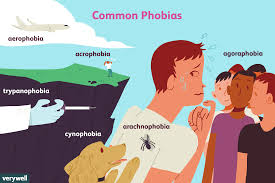 Many phobias of dubious value have been identified over the years. An article published in 1897 by G. Stanley Hall in the American Journal of Psychology noted “the absurd tendency to give Greek names to objects feared.” This gives us such worthless terms as koumpounophobia – fear of buttons, triakaidekaphobia – fear of the number 13, and coulrophobia – fear of clowns . This tendency has exploded with the growth of the internet. Click here for an incomplete list of these unnecessary but amusing “phobias,” complements of the army of volunteer editors at Wikipedia.
Many phobias of dubious value have been identified over the years. An article published in 1897 by G. Stanley Hall in the American Journal of Psychology noted “the absurd tendency to give Greek names to objects feared.” This gives us such worthless terms as koumpounophobia – fear of buttons, triakaidekaphobia – fear of the number 13, and coulrophobia – fear of clowns . This tendency has exploded with the growth of the internet. Click here for an incomplete list of these unnecessary but amusing “phobias,” complements of the army of volunteer editors at Wikipedia.
None of these is currently recognized as a specific psychiatric diagnosis. I guess we are slowly starting to abandon Latin in favor of clear communication!
Psychiatrists identify five types of “specific phobias:”
- · Animal
- · Natural environment (e.g., heights, storms, water)
- · Blood-injection-injury
- · Situational (e.g., fear of flying)
- · Other
 By definition, a “phobia” is “out of proportion to the actual danger posed.” That is the question we must consider. Is it possible that your fear is exaggerated? Not that it isn’t a real fear — only that it is “out of proportion.”
By definition, a “phobia” is “out of proportion to the actual danger posed.” That is the question we must consider. Is it possible that your fear is exaggerated? Not that it isn’t a real fear — only that it is “out of proportion.”
For example, many parents seem to think there is a sex-predator behind every tree. At least here in the US, the reality is that violent crimes, including stranger kidnappings, have reduced every year since 1972. In other words, my friends and I were in far more danger back in the 60s and 70s than kids are today; but the fear level is much higher now, because of the 24-hour news cycle, and the large number of police procedural TV shows. I find that if I can just get people to stop watching those kinds of programs their anxiety level drops almost immediately. We are almost literally scaring ourselves to death!
 Fear of flying is considered a “Specific Phobia, “because the fear is out of proportion with the actual danger. It is well documented that riding in a car is much more dangerous than flying. I often tell people that the drive to the airport is the most dangerous part of any trip. But people are afraid for the very reason you stated: news reports. Because place crashes are actually pretty rare, they are considered “newsworthy.” A plane crash anywhere on the planet gets world-wide coverage; as a result, people think they are much more common than they really are. The same is true for “terrorist attacks.” The news media (and politicians) like that word, because they know it will earn them lots of clicks, eyeballs or votes. Fear, after all, sells!
Fear of flying is considered a “Specific Phobia, “because the fear is out of proportion with the actual danger. It is well documented that riding in a car is much more dangerous than flying. I often tell people that the drive to the airport is the most dangerous part of any trip. But people are afraid for the very reason you stated: news reports. Because place crashes are actually pretty rare, they are considered “newsworthy.” A plane crash anywhere on the planet gets world-wide coverage; as a result, people think they are much more common than they really are. The same is true for “terrorist attacks.” The news media (and politicians) like that word, because they know it will earn them lots of clicks, eyeballs or votes. Fear, after all, sells!
One of the keys to understanding and managing these fears is recognizing and disputing “Cognitive Distortions.” Everyone makes these, but most people make two or three of them habitually (another really important concept). These are helpful because they give us a “common language” for thinking about our thoughts; but also I find that once we can name something, we can control it.
The thing about cognitive distortions, also known as “thinking errors,” is that they are not necessarily “errors.” One of the common thinking errors is “magnification.” A fear of germs is not irrational, in and of itself. The question is the degree of risk. Magnification, also known as “catastrophizing” is taking a real problem and making it bigger than it really is. Yes, every surface is covered with germs; but are they likely to hurt us? Probably not.
Another example is “Mental Filter.” This thinking error plagues scientists, who refer to it as “confirmation bias.” Essentially, once we have a belief, we tend to notice and dwell on evidence that supports that belief, to the exclusion of disconfirming evidence. That is why the scientific method includes replication studies, where other scientists repeat an experiment, with the specific intent of disproving the original findings. This is what makes science self-correcting; at least when things are done correctly. One of the goals of cognitive behavior therapy is to become as “self-correcting” as possible with our thoughts. That is why I say that one of my goals is to make each of my patients into his own therapist!